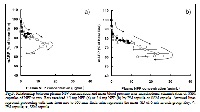Pharmacokinetic and pharmacodynamic evaluation of a new sustained-release capsules using starch-sponge matrix (SSM) release system for nifedipine in rats
Keywords:
Controlled-release, Cornstarch, Matrix, Nifedipine, Pharmacokinetics, PharmacodynamicsAbstract
We conducted a performance assessment study for a new sustained-release capsule including starch-sponge matrix (SSM). The SSM, which is a support medium for drug release, was made from 2.5% cornstarch glue by means of freezing dry method. The SSM capsule was applied for nifedipine (NFP), a calcium channel blocker, and evaluated pharmacokinetic and pharmacodynamic (PK/PD) profiles of NFP after intraduodenal administration of SSM capsules including 2.5 or 5.0 mg of NFP per capsule to rats. Plasma NFP concentrations from the SSM capsules showed dosedependent increases with a Michaelis-Menten like behavior over 360 minutes after intraduodenal administration. The values of area under the concentration vs. time curve from time zero to 360 min (AUC0-360) of NFP declined in making SSM capsules as compared to control capsules due to a simple physical mixture of NFP and cornstarch, but the values of mean residence time (MRT0-360) extended and abidingness of SSM capsules were admitted with dose-dependent manner. As for a PD parameter, the mean arterial blood pressure (mABP) derived from the SSM capsules showed 15~20% decrease of baseline within 120min after intraduodenal administration, and thereafter the mABP in 2.5 mg SSM capsule was gradually recovered, while a relatively smooth and even change was found in the mABP at 5.0 mg SSM capsule. The relationships between plasma NFP concentration and sampling-time corresponding mABP after intraduodenal administration of SSM capsules showed no rapid change in the mABP, indicating that a sustained-release mechanism due to the SSM functions sufficiently to avoid a fluctuating blood pressure accompanied by going up and down of plasma levels of NFP. The SSM capsules exhibited a sustainedrelease pharmacokinetics of NFP, and made the fluctuation range with blood pressure small compared to the physical mixture preparations. Thus, it was evidenced that the SSM capsule is useful device to provide a sustainedrelease systems and optimal therapeutic efficacy of drugs.
References
Chebli C, Cartilier L. Effect of some
physical parameters on the sustained
drugrelease properties of substituted
amylase matrices. Int J Pharm
;193:167–73.
Rahmouni M, Chouinard F, Nekka F,
Lenaerts V, Leroux JC. Enzymatic
degradation of cross-linked high amylase
starch tablets and its effect on in vitro
release of sodium diclofenac. Eur J Pharm
Biopharm 2001;51:191–8.
Pohja S, Suihko E, Vidgren M, Paronen P,
Ketolainen J. Starch acetate as a tablet
matrix for substained drug release. J Control
Release 2004;94:293–302.
Wierik G, Bergsma J, Arendsscholte AW,
Boersma T, Eissens AC, Lerk CF. A new
generation of starch products as excipient in
pharmaceutical tablets: 1. Preparation and
binding properties of high surface area
potato starch products. Int J Pharm
;134:27–36.
Herman J, Remon JP, Devilder J. Modified
starches as hydrophilic matrices for
controlled oral delivery: 1. Production and
characterization of thermally modified
starches. Int J Pharm 1989;56:51–63.
Mohile RB. Formulation of sustained release
oral dosage from using pregelatinized starch.
Int J Pharm Sci 1986;25:150–6.
Sanchez L, Torrado S, Lasters JL.
Gelatinized freeze-dried starch as excipient
in sustained-release tablets. Int J Pharm
;115:201–8.
Shibata N, Nishimra A, Naruhashi K, Nakao
Y, Miura R. Preparation and pharmaceutical
evaluation of new sustained-release capsule
including starchsponge matrix (SSM).
Biomed Pharmacother 2011;64:352–8.
Agnihotori SA, Mallikarjunna NM,
Aminabhavi TM. Recent advances on
chitosan-based micro- and nanoparticles in
drug delivery. J Control Release
;100:5–28.
Wu KE, Li J, Wang W, Winstead DA.
Formation and characterization of solid
dispersions of piroxicam and
polyvinilpyrrolidone Using spray drying and
precipitation with compressed antisolvent. J
Pharm Sci 2008;29:1–10.
Leonardi D, Barrera MG, Lamas MC,
Salomon CJ. Development of Prednisone:
polyethylene glycol 6000 fast-release tablets
from solid dispersions: solidstate
characterization, dissolution Behavior, and
Formulation Parameters. AAPS Pharm Sci
Tech 2007;8:E1–8.
Takeuch H, Nagira S, Yamamoto H,
Kawashima Y. Solid dispersion particles of
amorphous indomethacin with fine porous
silica particles by using spraydrying method.
Int J Pharm 2005;293:155–64.
Wang L, Cui FD, Sunada H. Preparation and
evaluation of solid dispersions of
Nitrendipine prepared with fine silica
particles using the melt-mixing method.
Chem Pharm Bull 2006;54:37–43.
Dawes GJ, Fratila-Apachitei LE, Mulia K,
Apachitei I, Witkamp GJ, Duszczyk J. Size
effect of PLGA spheres on drug loading
efficiency and release profiles. J Mater Sci
Mater Med 2009; 20: 1089–94.
Fukushima T, Kawaguchi M, Hayakawa T,
Takeda S, Inoue Y, Ohno J, et al. Drug
binding and releasing characteristics of
DNA/lipid/PLGA film. Dent Mater J
;268:54–60.
Martinac A, Filipovic-Grcic J, Voinovich D,
Perissutti B, Franceschinis E. Development
and bioadhesive properties of chitosan-
ethylcellulose microsperes for nasal
delivery. Int J Pharm 2005;291:69–77.
Govender S, Pillay V, Chetty DJ, Essack
SY, Dangor CM, Govender T. Optimization
and characterization of bioadhesive
controlled release tetracyclinemicrospheres.
Int J Pharm 2005;36:24–40.
Dai C, Wang B, Zhao H.
Microencapsulation peptide and protein
drugs delivery system. Colloids Surf B
Biointerfaces 2005;41:117–20.
Senel S, Capan Y, Hincal AA. Factors
affecting the formulation of sustained
release potassium chloride tablets.
Pharmazie 1991;46:792–5.
Akiyama Y, Nagahara N, Kashihara T, Hirai
S, Toguchi H. In vitro and in vivo evaluation
of mucoadhesive microspheres prepared for
the gastrointestinal tract using polyglycerol
esters of fatty acids and a poly(acrylic acid
derivative. Pharm Res 1995;12:397–405.
Eaimtrakarn S, Itoh Y, Kishimoto J,
Yoshikawa Y, Shibata N, Takada K.
Retention and transit of intestinal
mucoadhesive films in rat small intestine.
Int J Pharm 2001;224:61–7.
Eaimtrakarn S, Rama Prasad YV, Puthli SP,
Yoshikawa Y, Shibata N, Takada K.
Possibility of a patch system as a new oral
delivery system. Int J Pharm 2003;250:111–
Lise AE, Fakhreeddin J. Pharmacokinetics
and pharmacodynamics of nifedipine in
untreated and atorovastatin-treated
hyperlipidemic rats. J Pharmacol Exp Ther
;291:188-193.
Holtbecker N, Fromm MF, Kroemer HK,
Ohnhaus EE, Heidemann H. The
nifedipinerifampin interaction: evidence for
induction of gut wall metabolism. Drug
Metab Dispos 1996;1121:1121-3.
Saseen JJ, Cather BL, Brown TER, Elliott
WJ, Black HR. Comparison of Nifedipine
alone with diltiazem or verapamil in
hypertension. Hypertention1996;28:109-






